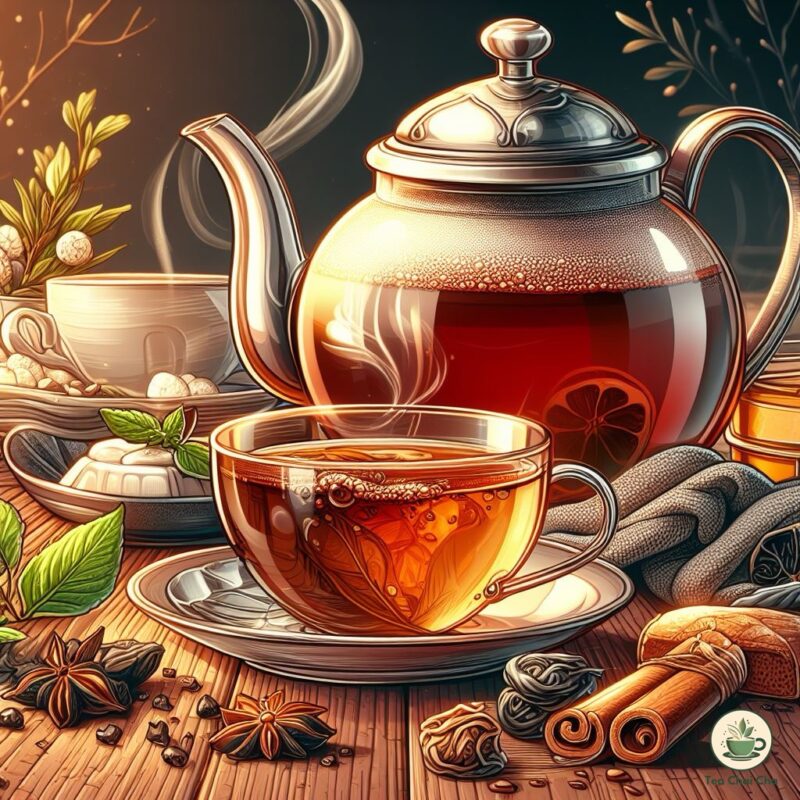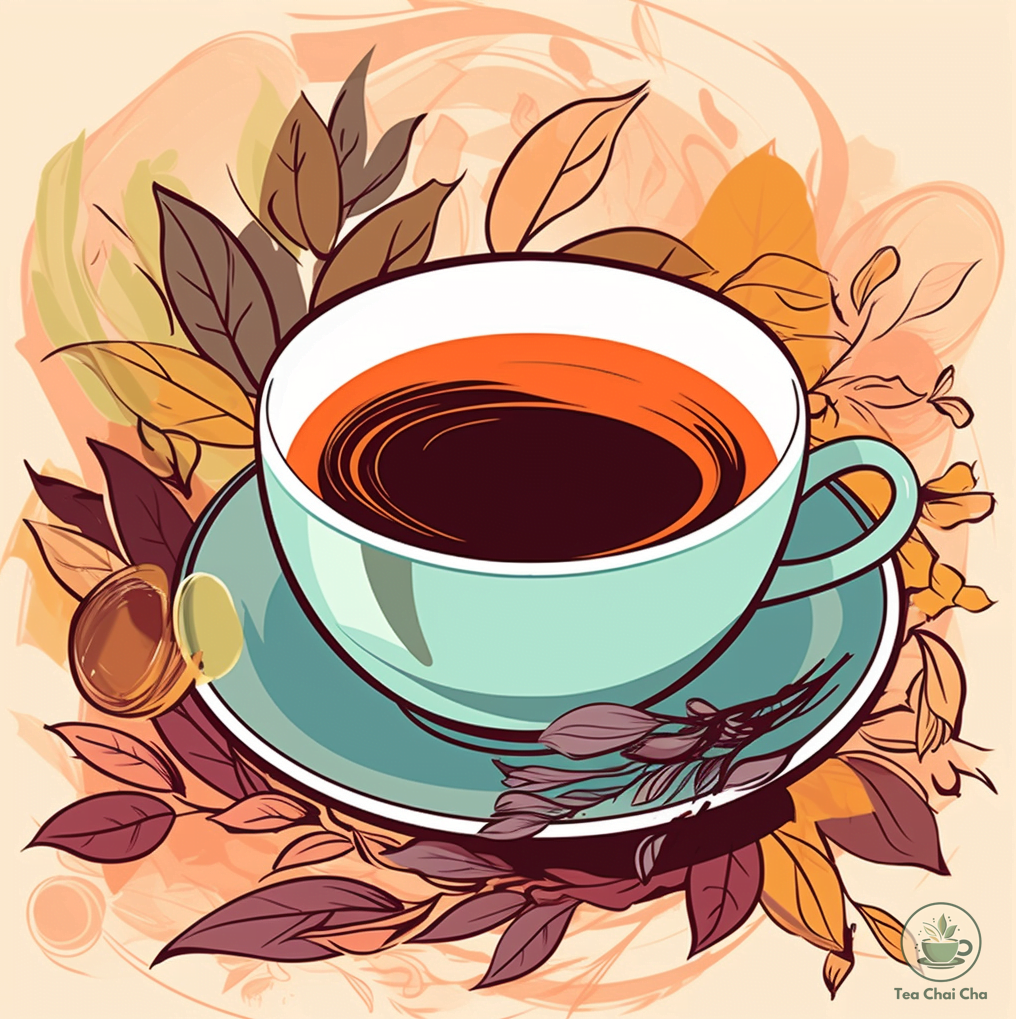When I kickstart my day, there’s nothing like a steaming cup of black tea to set the tone.
And when the sun’s high up, I rely on a refreshing iced blend to keep me going.
If you’re looking to savor the rich, bold flavors of black tea, you’re in for a treat.
Now, about brewing this beauty – there’s no one-size-fits-all approach, but I’ve got some tips to make sure you hit the mark.
Quality and temperature play tag here, making sure your cuppa turns out just right.
Stick around, and I’ll spill the tea on how to nail that perfect black tea brew every single time.
What is Black Tea?
Black tea is a real tea that comes from the Camellia sinensis plant. It’s known as one of the strongest teas out there.
We’ve some other true teas too, like the gentle white tea, the friendly green tea, and even the in-between oolong tea and aged pu-erh tea.
These are the only teas that actually come from the tea plant itself.
Everything else, like those herbal teas, comes from different parts of other plants, like roots, flowers, stems, and herbs.
It’s a tea that’s fully oxidized which gives it a rich and bold flavor.
When you steep black tea leaves in hot water, you’ll notice the liquid turns a deep, dark color.
This type of tea has a strong taste, often with notes of malt, fruitiness and sometimes even a hint of smokiness.
Why Is It Called Black Tea?
It’s actually called “black tea” because of how the tea leaves look after they’re processed.
When tea leaves are picked, they’re all green and fresh. But for black tea, they go through a special process called oxidation.
It’s like when you cut an apple and leave it out – it turns brown over time, right?
That’s kind of what happens with black tea leaves, but in a controlled way.
During oxidation, the leaves turn darker and kind of blackish. This process changes the flavor and color of the tea.
The longer the oxidation, the stronger the flavor.
So, even though the leaves start out green, they end up black-ish, and that’s why we call it black tea.
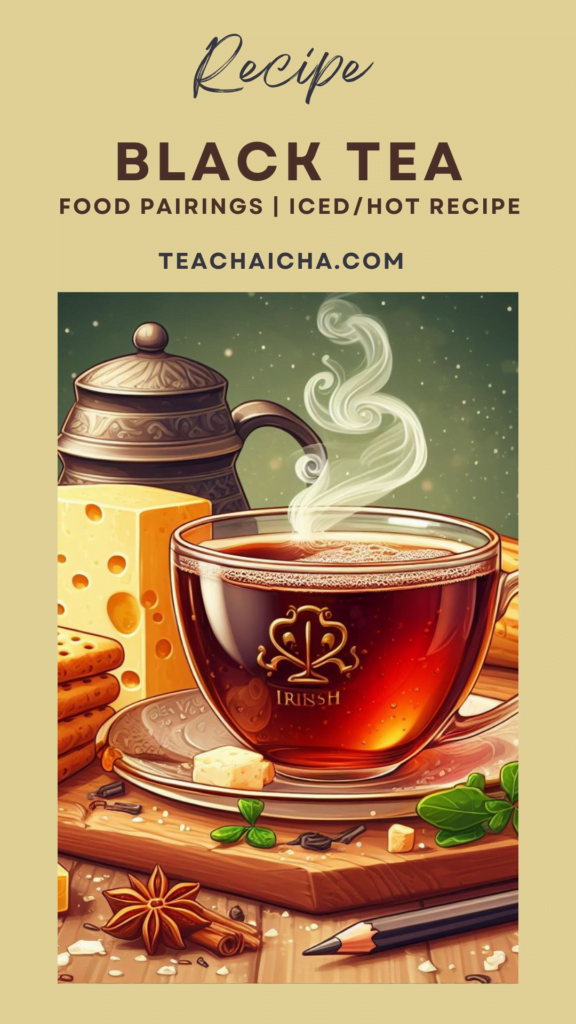
How to Make Black Tea
Making black tea is a breeze, and I’m here to guide you through it. But let’s first talk in detail about the ingredients and tools you need to brew a perfect cup of black tea.
If you are just starting out, I have some suggestions for you.
Ingredients
Black Tea Leaves: These are the heart and soul of your cuppa.
Opt for high-quality loose black tea leaves for the best flavor.
Darjeeling, Assam, or Earl Grey are popular choices. Experiment with different types to find your favorite.
Water: Start with fresh, cold water. Use filtered water if possible, as impurities in tap water can affect the taste.
The temperature of the water matters too.
Boil the water and let it sit for a moment (about 30 seconds) before pouring it over the tea leaves.
This ensures the perfect temperature for steeping.
Sweetener: If you enjoy a touch of sweetness, consider using honey, sugar, or even a pinch of stevia.
Keep in mind that the sweetness can enhance the tea’s flavors.
However, I encourage you to start with a small amount and adjust to taste.
Milk: If you like your tea creamy and comforting, milk is a wonderful addition.
It’s best to use whole milk or non-dairy alternatives like almond, soy, or oat milk.
Add the milk after steeping the tea, as it can cool down the water and affect the steeping process.
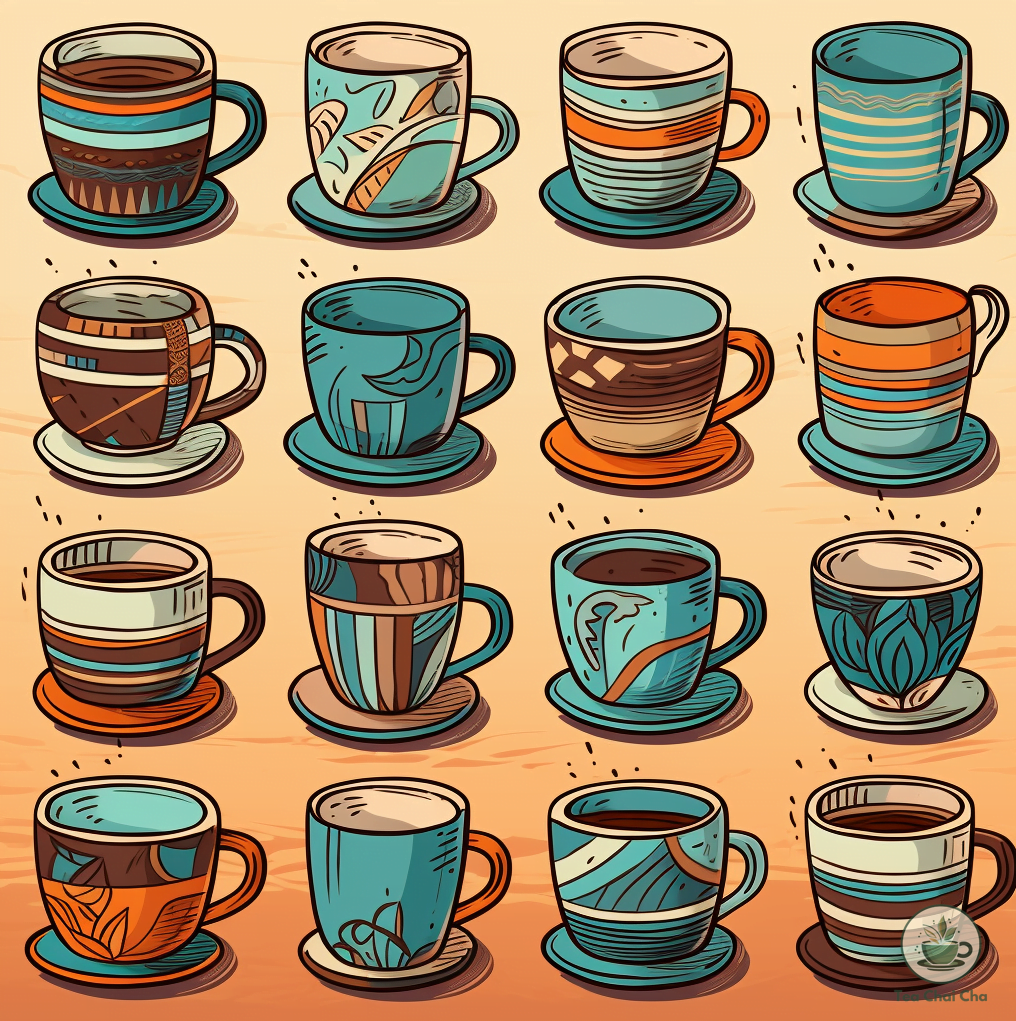
Equipment
Teapot or Kettle: A sturdy teapot or kettle is your brewing buddy. Choose one with good heat retention.
If you’re a tea enthusiast, investing in a variable temperature kettle can take your tea game to the next level, allowing you to brew different teas at their ideal temperatures.
Teacup or Mug: The vessel you choose matters. A porcelain or ceramic cup retains heat well and won’t interfere with the taste of your tea.
A larger mug allows the tea’s aroma to fully develop, enhancing your experience.
Tea Infuser or Strainer: Using loose tea leaves? A reliable infuser or strainer is a must.
Look for one with fine mesh to prevent any bits of leaves from escaping into your cup. If you’re into convenience, tea bags work too.
Spoon: A simple tool, but crucial for adding sweeteners. Stir gently to blend in honey or sugar evenly.
Stovetop or Electric Kettle: The key is to heat water to the right temperature.
An electric kettle with temperature settings or a stovetop kettle with a built-in whistle is ideal. It’s all about precision for that perfect brew.
Related – Tea Accessories and Their Uses
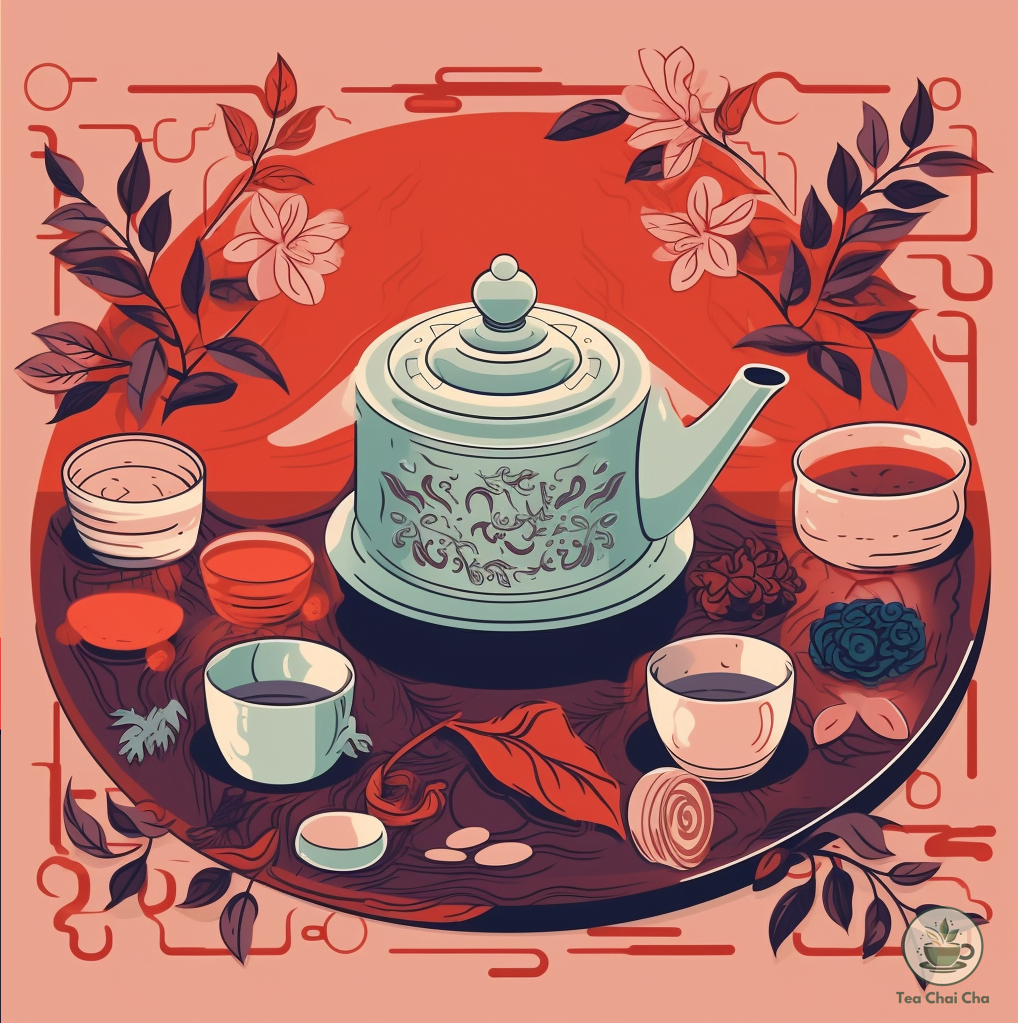
How to Make Black Tea Step-by-Step
Making black tea is one of my favorite things, and I’m excited to share this step-by-step guide with you. If you’re new to the world of tea, don’t worry—making black tea is super easy and oh-so-rewarding!
Tea Selection
Step 1: Pick from different tea forms to brew
So, when it comes to choosing the tea I want to brew, I’ve got a few options: loose tea, tea sachets, or tea bags.
Loose tea is my go-to for the best flavor because those leaves are big and burst with lots of taste.
When I go for loose tea, I use a strainer or a tea infuser – that’s like a little basket to hold the tea. It’s kind of fun to watch the leaves unfurl as they steep.
Now, there are these pyramid-shaped tea sachets, and they’re cool too.
They let the tea leaves stretch out and brew nicely.
And then there are tea bags with smaller bits of tea called fannings.
But if I’m honest, on the quality scale, tea bags come in last for me.
Some people are super into loose leaf only, but I mix it up.
Loose leaf is my go-to for relaxed weekends, while I enjoy Harney tea sachets, Pukka, and Tazo tea bags for the everyday hustle.
It all boils down to what tickles your taste buds.
One last thing before we start steeping: take a peek at the info on the package.
It’s got the scoop on how hot the water should be and how long to let the tea do its thing.
Remember those details – they make a difference!
High Quality/Filtered Water
Step 2: Fill tea kettle with filtered water
When I’m getting ready to brew a delicious cup of tea, I always start with the most important ingredient: water.
Yep, you heard me right—water is the superstar here. So, here’s what I do: I pour filtered water into my trusty tea kettle.
Now, you might be thinking, “Does water really make that big of a difference?”
Well, let me tell you, it absolutely does. Go on, take a sip of tap water and then a sip of filtered water.
See the difference? It’s like night and day!
Whether I’m making tea, coffee, or even whipping up some lemonade, I stick to using filtered water.
I’ve this cool fridge with a built-in filter that gives me the purest, yummiest water and ice.
But don’t sweat it if you don’t have that fancy feature.
There are these nifty filter pitchers that work like a charm.
Just fill one up, pop it in the fridge, and voilà! You’ve got filtered water ready to pour into your tea kettle.
Heat Water At the Right Temperature
Step 3: Boil water in kettle or use stove top
One crucial step I always pay attention to is heating the water to the right temperature. This step sets the stage for the flavorful experience ahead.
Different types of tea, whether it’s the vibrant black, soothing green, or delicate white tea, have their own preferences when it comes to water temperature.
Let me share an interesting tidbit with you: green tea is a bit like a delicate flower—it doesn’t appreciate being dunked into boiling water.
Boiling water can actually harm those precious green tea leaves, so it’s best to avoid it.
Now, let’s focus on the star of the show: black tea. Trust me, the temperature of the water matters more than you might think.
If it’s too chilly, it won’t coax out all those wonderful flavors.
Unlike green tea, black tea goes through a longer processing journey, and to truly capture its essence, it needs water that’s just about to reach a boil.
As for boiling water, I use an electric tea kettle.
I fill it with pure, filtered water, and with a press of a button, I choose the setting for black tea. Simple as that.
What’s even more nifty is that my kettle has this handy little window to check the water level, and it cheerfully beeps when the temperature is spot on.
However, if you’re more of a traditionalist and like the charm of the stovetop, that’s perfectly fine too.
Just make sure to check the temperature recommendation on your tea box.
For most black teas, you’re looking at a rolling boil.
And here’s a little trick I’ve picked up: once the water’s bubbling away, give it a moment to settle down before you pour it over your tea leaves. A few seconds can make a real difference.
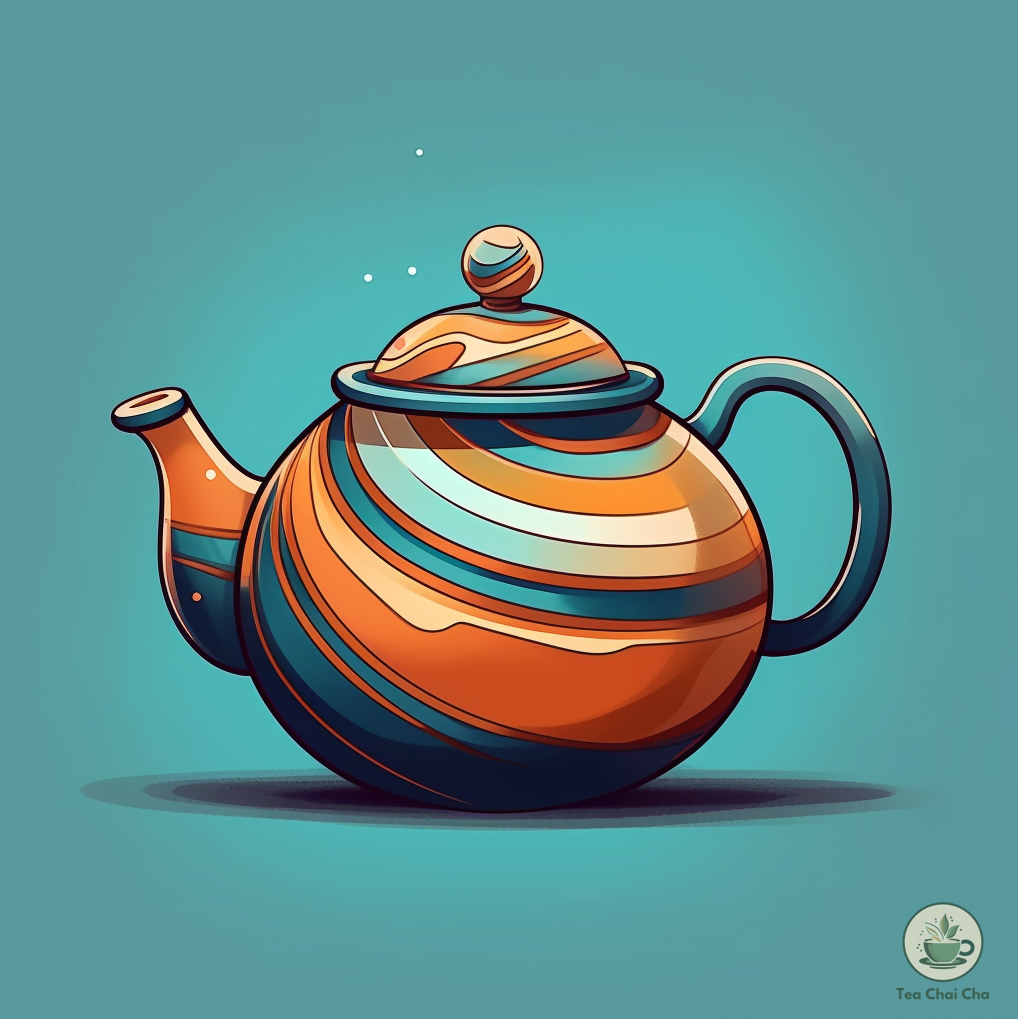
Warm Up Tea Cups and/or Teapot
Step 4: Pre-heat your tea cup/mug or a teapot if you use one
So, let’s talk about getting all cozy with your tea brewing setup.
You know, I sometimes skip this step out of pure laziness, but trust me, it’s worth it.
Here’s the scoop: grab your favorite cup or teapot and pour in a bit of hot water. Just a little splash will do.
Now, give it a few moments to soak up that warmth.
While you wait, you can even sneak in a quick hand-warming session by hugging your cup – if it’s too hot to handle, then it’s ready!
Once you’ve had your hug and the cup is all toasty, pour out the water. Ta-da!
But why go through this trouble, you ask?
Well, remember how I blabbered about water temperature earlier?
If you pour hot water into a chilly cup, it loses its heat super fast.
Preheating makes sure your tea stays at the right temperature to bring out all those amazing flavors.
Oh, and here’s a neat trick: if you’re using the same teapot to boil water and brew your tea, you can totally skip this step.
Lazy win, right? So there you have it – a little preheating love goes a long way in making your tea taste oh-so-good.
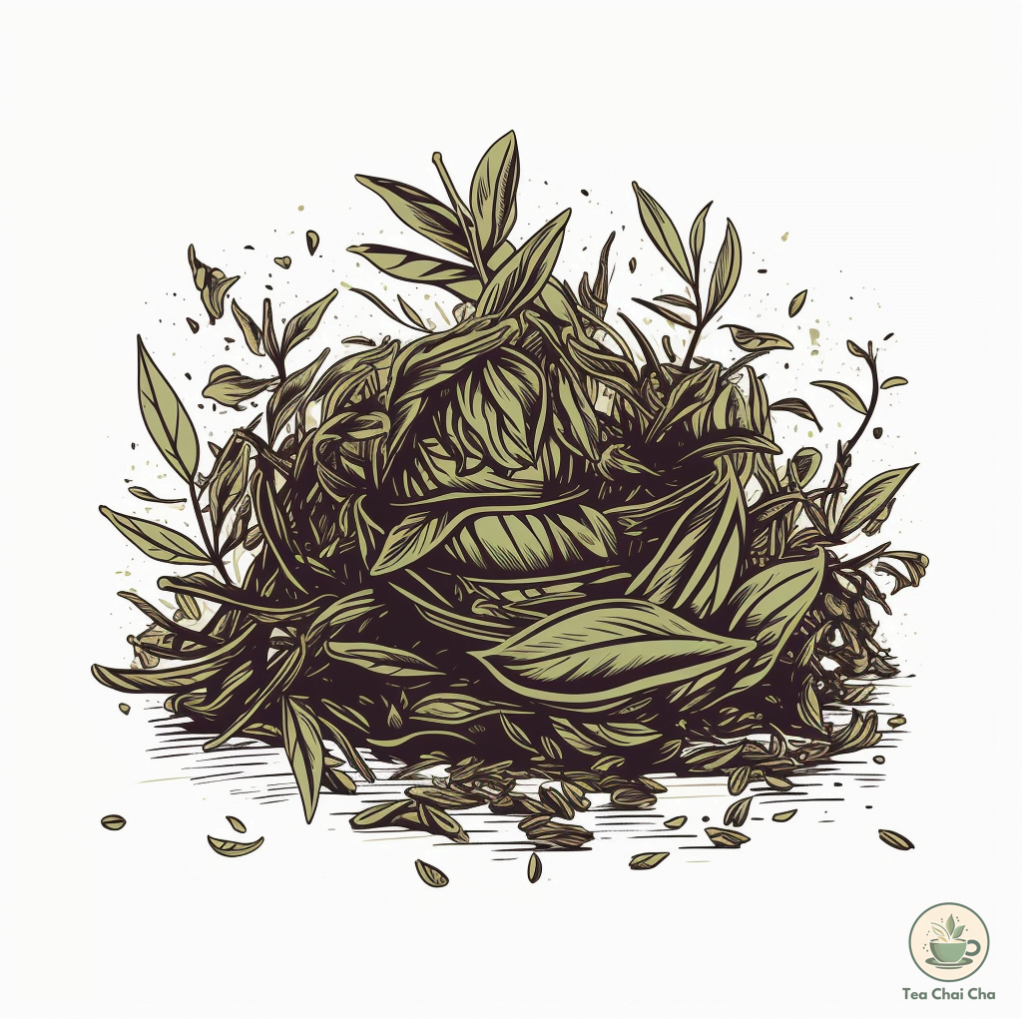
Measure Your Black Tea Leaves
Step 5: Fill infuser with tea leaves, put it in mug or teapot andpour hot water
Now comes the fun part – brewing the tea. But wait, how much tea should I use? No worries, I’ve got you covered!
If you’re using tea bags, a simple rule is one tea bag for each 8 ounces of water.
For loose tea, around 1 to 2 teaspoons per 8 ounces of water is usually just right. Don’t forget, the tea box or tin might have its own instructions too.
Oh, and if you’re scratching your head about the size of your mug, just flip it over.
Sometimes, the bottom has the ounces printed. Or, you can grab a measuring cup and find out its capacity.
Remember, nailing the tea-to-water ratio is key to a great cup.
Too little tea and it’ll taste weak, but too much and it might knock your socks off with strength.
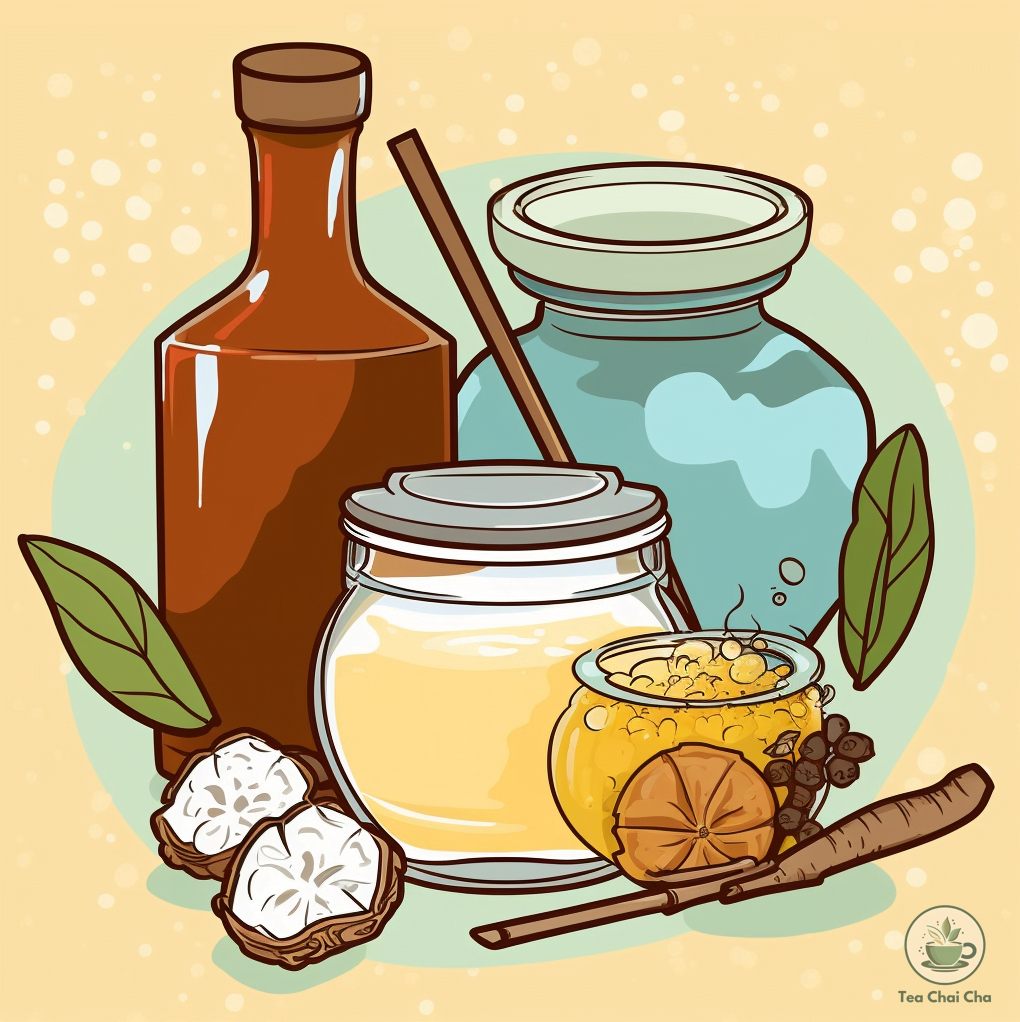
Dissolve Sweetener While Tea’s Steeping
Step 6: Mix raw sugar or cane sugar in the mug or teapot
I’ve a trick for you when it comes to making that perfect cup of black tea.
When I’m in the mood for a touch of sweetness, I love adding a bit of cane sugar or raw sugar right into my tea as it’s steeping.
Now, I must admit, I’ve been on a mission to cut down on sugar lately, so sometimes I enjoy my tea without any sweetness.
But, there’s something about a splash of milk and a hint of sugar that just makes my morning cuppa feel extra special.
Especially when it’s English Breakfast tea – that’s my go-to for a bright start to the day.
And guess what?
On days when I’m treating myself (we all deserve a treat, right?), I whip up a delightful brown sugar milk tea.
So, if you’re a fan of sweetened black tea, give this a shot. Toss in your sugar while your tea leaves are doing their steeping thing.
The hot water does wonders in dissolving that sweetness, creating a harmony of flavors that’s hard to resist.
How Long to Steep Black Tea
Step 7: Use a timer to note the steeping time
Steeping black tea is the real deal in making that perfect cup. And timing really matters.
If you’re in a hurry and just dip that tea bag like a quick hello, your cup might feel a bit shy on flavor and that caffeine buzz.
But don’t overstay the welcome.
If you let the tea chill in there too long, those tannins can totally crash the party and make things bitter.
For the sweet spot, go for at least 3 minutes of steeping for that flavor and caffeine magic.
Don’t push it past 5 minutes though – time flies, especially when you’re multitasking in the kitchen. I’m not kidding, I set a timer on my phone.
Because let me tell you, a black tea that’s been mingling for six minutes? That’s a no-go, straight down the sink.
So, remember, 3 to 5 minutes is where the taste party’s at.
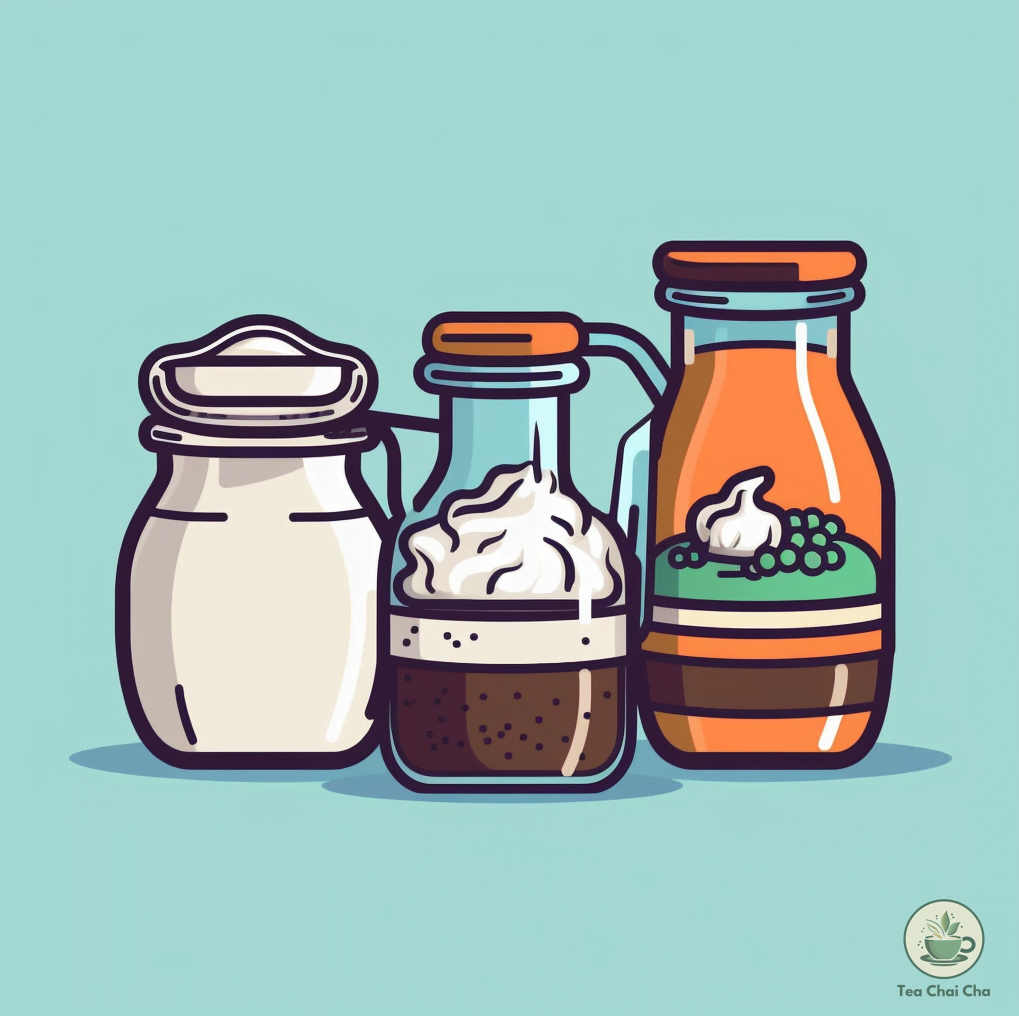
Add Other Additives
Step 8: Mix in milk of your choice, syrup, or anything else you want the taste of
Let’s take your black tea to the next level! Once your tea is all brewed up, it’s time to have some fun and add extra flavors if you’re in the mood.
If you’re a fan of creamy goodness, like me, turn your black tea into a latte.
Just pour in some warm, frothy milk. I’m a big fan of Earl Grey tea, and let me tell you, a latte made with it is a real treat.
Now, let’s talk sweetness. If you’ve got a bit of a sweet tooth like I do, simple syrup is your new best friend.
I adore adding vanilla simple syrup or honey simple syrup to my black tea.
And here’s a secret indulgence for you: chai tea magic.
Especially when fall rolls around, I can’t resist a pumpkin spice chai latte. It’s like autumn in a cup, seriously.
Just pour your chai tea, add some homemade pumpkin spice sauce (think Starbucks vibes), and pour in steamed milk.
To make it picture-perfect, a sprinkle of pumpkin spice on top is a must.
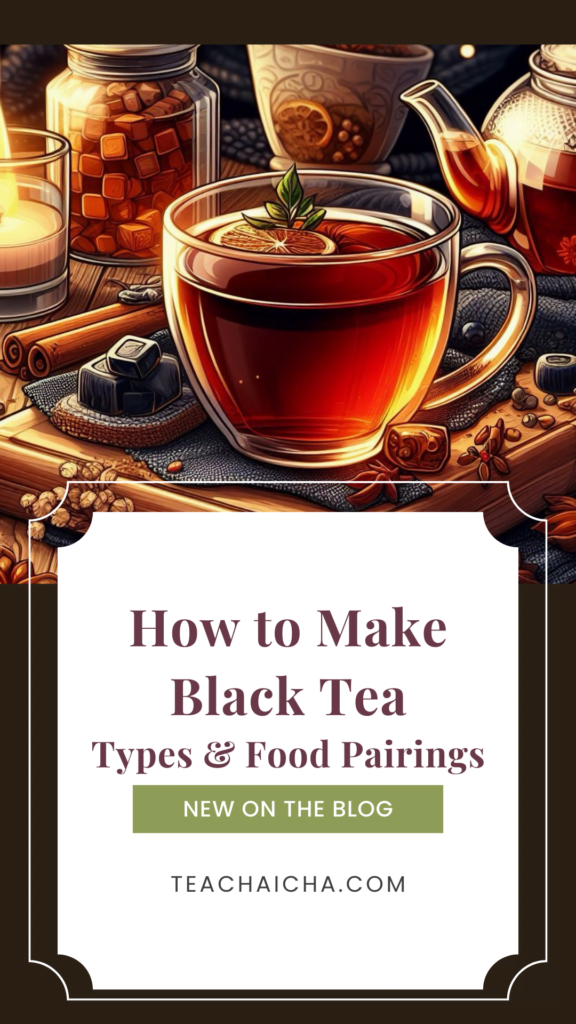
Classic Black Tea Recipe
Recipe by Tania FaysalCourse: DrinksCuisine: Chinese, Asian2
servings5
minutes3
minutes2
kcal8
minutesWhether enjoyed plain or with a touch of milk and sweetness, this classic black tea recipe offers comforting warmth and rich aromas.
Ingredients
- Ingredients
2 teaspoons of high-quality loose-leaf black tea
2 cups of water
- Additives (Optional)
Milk
Honey or sugar
- Tools You'll Need
Kettle
Teapot
Tea infuser or teaspoon
Cups for serving
Directions
- Boil Water: Begin by filling your kettle with fresh water and bringing it to a boil. The ideal water temperature is around 212°F (100°C).
- Warm the Teapot: While the water is heating, pour a small amount of hot water into your teapot to warm it up. This helps maintain the temperature of your tea.
- Measure Tea Leaves: Use a tea infuser or a teaspoon to measure 2 teaspoons of loose-leaf black tea leaves. Place these leaves into the warmed teapot.
- Pour Hot Water: Once your water reaches a rolling boil, carefully pour it over the tea leaves in the teapot, ensuring they are fully submerged.
- Steep the Tea: Cover the teapot with its lid and allow the tea to steep for 3-5 minutes. This time lets the flavors fully develop and the tea leaves to unfurl.
- Add Milk and Sweetener (Optional): After steeping, you can enhance your tea by adding a splash of milk for creaminess and a drizzle of honey or a bit of sugar for sweetness. Adjust the amounts to your liking.
- Pour and Enjoy: Once you've added any desired additives, pour the brewed tea into cups and savor the delightful flavors.
Recipe Video
Black Tea Hot or Cold?
When it comes to black tea, you’ll find that enjoying it both hot and cold brings its own unique pleasures.
On those chilly mornings or whenever you’re seeking a comforting pick-me-up, a steaming cup of hot black tea will be your ideal choice.
You might want to consider using Assam tea for this purpose.
As the warmth seeps through your mug, coupled with the rich and bold flavor of Assam tea, it’s bound to give you an instant lift.
If you like, you can add a touch of honey to subtly sweeten it, creating a delightful balance of flavors personalized just for you.
Now, picture those sunlit afternoons when the heat is on, and you’re in the mood for something refreshing.
This is when you can turn to cold-brewed black tea – and for this preparation, Darjeeling tea works wonders.
I usually steep the tea leaves in cold water overnight. It creates a crisp drink I love sipping on a warm day.
To enhance that coolness and add a hint of zest, you might consider adding a slice of lemon or a sprig of fresh mint.
So, whether you’re embracing the coziness of a hot cup of Assam tea or relishing in the revitalizing coolness of a cold-brewed Darjeeling tea, black tea is here to cater to your every mood and weather.
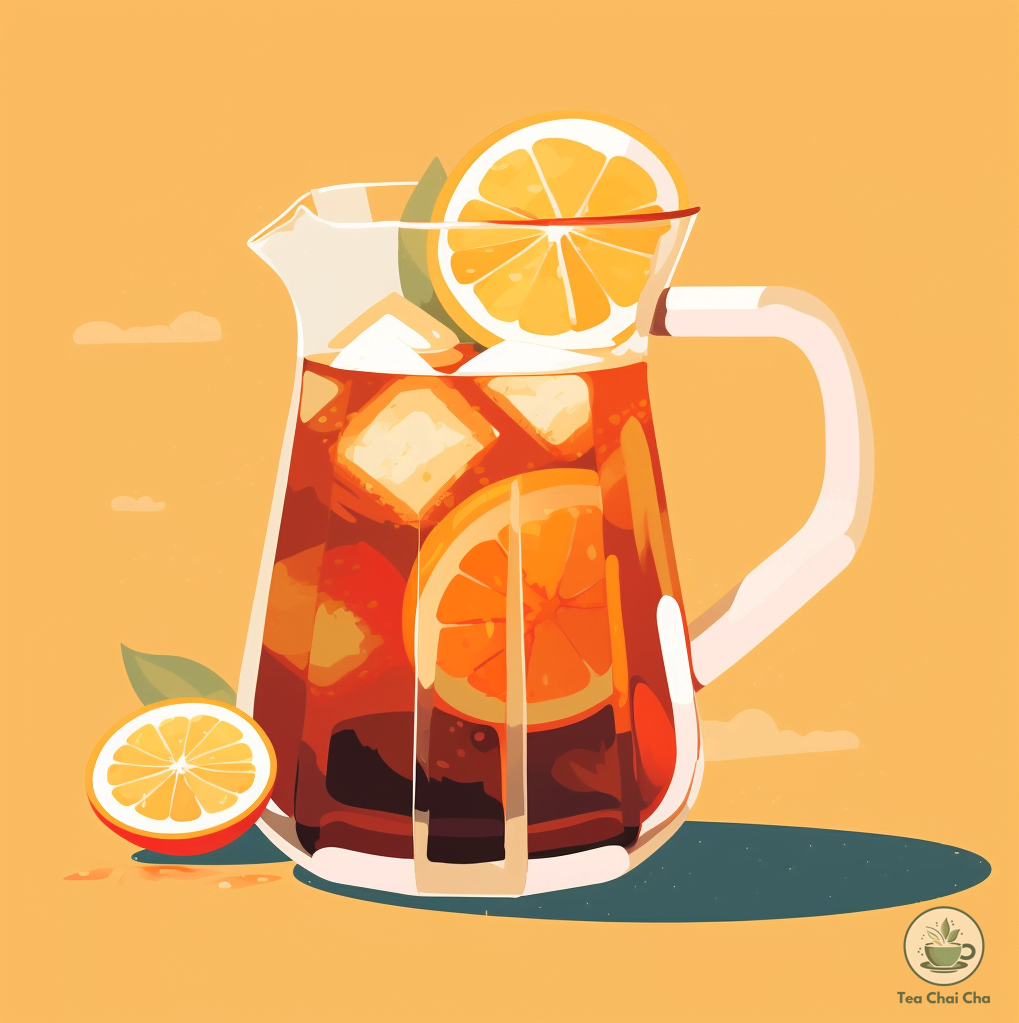
How to Make Iced Black Tea
Making iced black tea is a breeze, and it’s the best way to stay refreshed on warm days. Here’s a simple step-by-step black tea recipe to creating your own delicious batch of iced black tea:
Ingredients
- 4-5 teaspoons of black tea leaves (like Darjeeling)
- 4 cups of water
- Ice cubes
- Optional sweetener (sugar, honey, etc.)
- Optional flavorings (lemon slices, mint leaves, fruit juice)
Directions
1. Boil Water: Start by boiling water. For a standard pitcher, you’ll need about 4 cups of water.
Once the water reaches a rolling boil, remove it from the heat and let it cool for a minute or two.
2. Add Tea Leaves: Measure out around 4-5 teaspoons of black tea leaves (adjust according to your taste preferences) and place them in a teapot or heatproof pitcher.
3. Pour Hot Water: Carefully pour the hot water over the tea leaves. Let the tea steep for about 3-5 minutes.
You can adjust the steeping time based on how strong you want the tea to be.
4. Remove Tea Leaves: After the steeping time, remove the tea leaves by either straining them out or removing the tea bag.
Don’t let the tea over-steep, as it can become bitter.
5. Sweeten (Optional): If you prefer your iced tea sweetened, you can add sugar, honey, or any sweetener of your choice while the tea is still warm.
Stir until the sweetener is completely dissolved.
6. Cool Down: Allow the brewed tea to cool down to room temperature.
You can speed up this process by placing the pitcher in the refrigerator.
7. Refrigerate: Once the tea has cooled, transfer the pitcher to the refrigerator and let it chill for at least an hour.
This will ensure your iced black tea is thoroughly chilled and ready to be served.
8. Serve with Ice: When you’re ready to enjoy, fill glasses with ice cubes and pour the chilled black tea over the ice.
9. Add Flavorings (Optional): To take your iced black tea to the next level, add flavorings like fresh lemon slices, a sprig of mint, or even a splash of fruit juice.
These additions can enhance the taste and provide a lovely aroma.
10. Sip and Enjoy: Grab a comfortable spot, take a sip, and relish in the cool and flavorful goodness of your homemade iced black tea.
6 Factors That Affect the Flavor of Black Tea
Here’s a scoop on some factors that have a great impact on the flavor of black tea.
Tea Leaves’ Origin
The place where the tea leaves are grown plays a big role in their flavor. Just like grapes for wine, the soil, climate, and altitude impact the taste of tea.
For instance, a black tea from Assam, India might have a malty and bold flavor, while a Chinese Keemun might offer a more smoky and fruity note.
Processing Techniques
How tea leaves are processed after plucking matters too. Black tea undergoes oxidation, which gives it that rich color and distinctive taste.
The level of oxidation, rolling, and drying affects the flavor. It’s like crafting a masterpiece with every step.
Tea Leaf Grade
The size and quality of the tea leaves matter. Broken leaves might release more bitterness, while whole leaves provide a smoother and complex taste. It’s like using fresh, prime ingredients for a recipe.
Brewing Time and Temperature
Like cooking a dish, brewing tea requires the right timing and temperature.
Steeping black tea for 3-5 minutes at around 200°F (90°C) is usually ideal.
Adjusting this can bring out different flavor profiles – a shorter steep might be brisk and bright, while a longer one might be deeper and more robust.
Water Quality
Just as water affects the taste of food, it influences tea flavor. Fresh, filtered water without strong mineral flavors is best.
Water that’s too hard or too soft can mask or distort the delicate notes of the tea.
Storage
Properly storing your tea is like preserving a treasured ingredient. Keep it away from moisture, light, and strong odors. This helps maintain the tea’s original flavor and aroma.
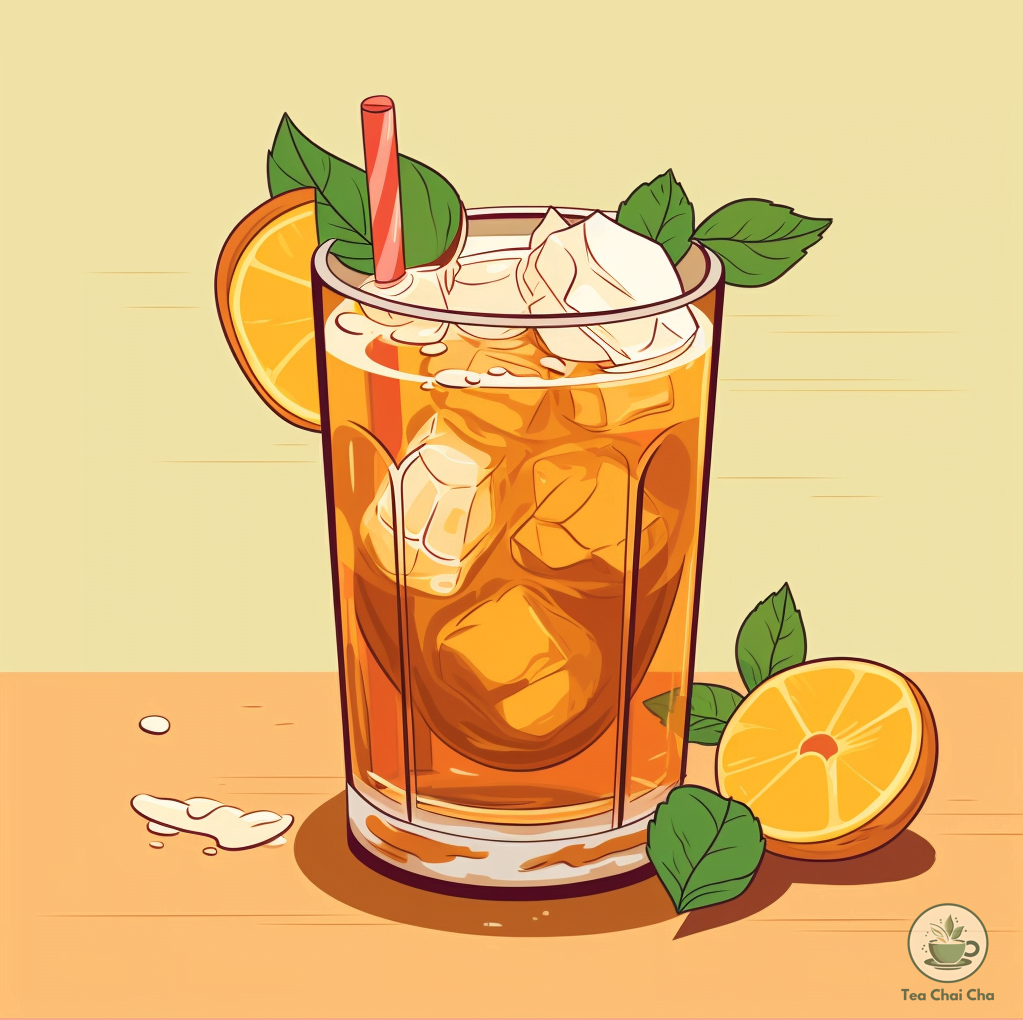
How to Make Black Tea Taste Good
I found that experimenting with different flavors can be a lot of fun and really improve your tea experience.
Here are some of my favorite ways to add a delicious twist to black tea:
Fruity Infusion
One of my go-to tricks is to add a splash of fruitiness to my black tea. I love dropping a few slices of fresh orange or a handful of berries into my cup before steeping.
The natural sweetness of the fruits complements the robustness of black tea, creating a balanced and refreshing taste.
Spiced Delight
Adding a pinch of warming spices can transform your black tea into a cozy treat.
I often sprinkle in a bit of cinnamon or a touch of cardamom. It’s like a comforting hug in a cup, especially on a chilly day.
Floral Elegance
For a touch of sophistication, I like to experiment with floral notes.
Adding a few rose petals or lavender buds to my black tea creates a delicate and aromatic blend. It’s like sipping serenity with every sip.
Nutty Nuances
To bring a rich depth of flavor, I sometimes toss in a crushed almond or two.
This imparts a subtle nuttiness that perfectly complements the boldness of black tea. It’s like enjoying a slice of almond cake without the guilt!
Sweet and Spontaneous
When I’m feeling a bit indulgent, I might drizzle a tiny bit of honey into my cup.
The natural sweetness enhances the tea’s flavors and adds a luxurious touch. Just a teaspoon can go a long way.
Citrus Zest
Adding a small strip of lemon or lime zest can give your black tea a zesty kick.
The citrus oils release a burst of freshness that pairs wonderfully with the tea’s deep flavors. It’s like a sunny citrus getaway in a cup.
Creamy Bliss
For a luxurious twist, I sometimes add a splash of creamy milk to my black tea.
This creates a velvety texture and softens the tea’s intensity. It’s akin to savoring a soothing latte, but with the charming character of black tea.
Choco Infusion
A touch of cocoa can be a delightful surprise in your cup of black tea.
Adding a sprinkle of unsweetened cocoa powder lends a subtle chocolatey note that dances with the tea’s richness. It’s like a dessert without the guilt!
Minty Freshness
If I’m craving something refreshing, I might toss a few fresh mint leaves into my black tea.
The minty aroma and taste provide a cooling sensation that awakens the senses. It’s like a rejuvenating spa experience in every sip.
Tropical Paradise
Dreaming of a tropical escape? Try dropping a slice of pineapple or a bit of coconut into your black tea.
The tropical flavors transport you to an island paradise, even if you’re just sipping at home.
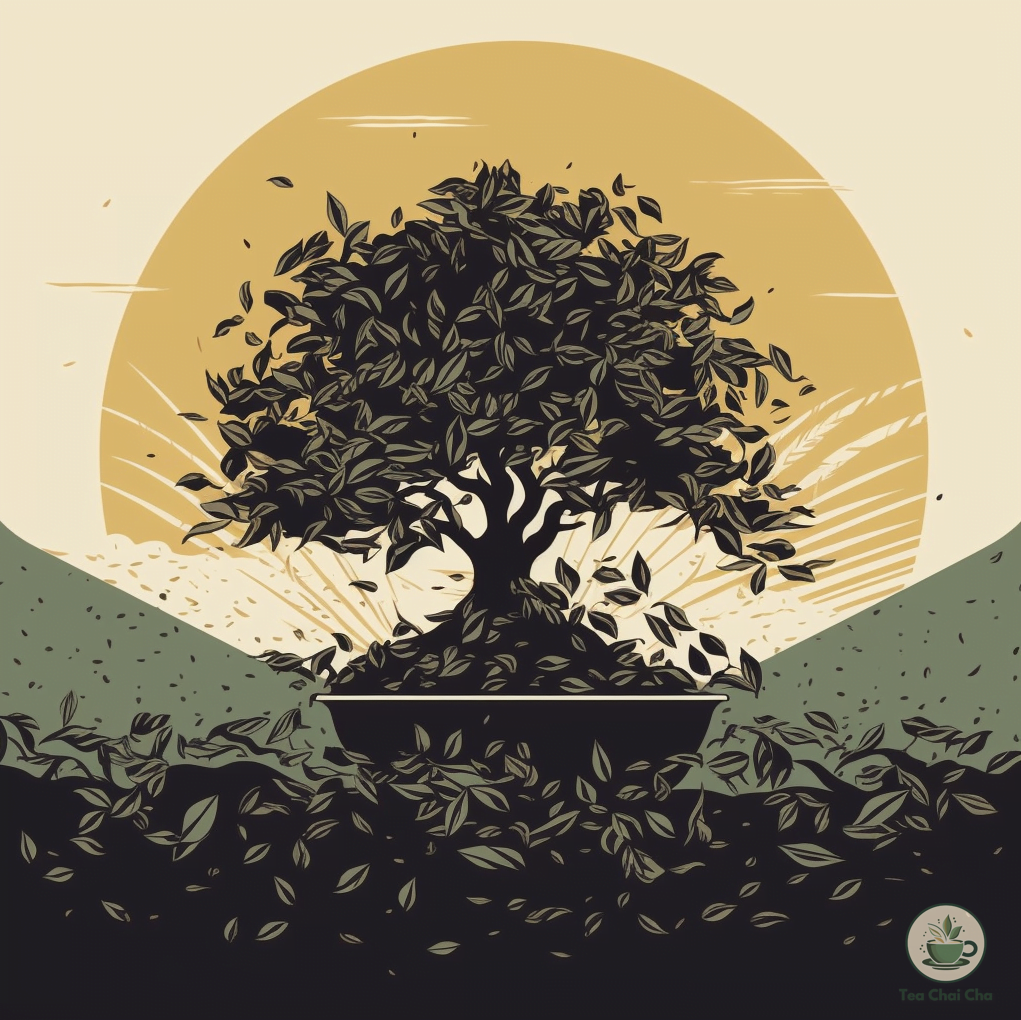
22 Types of Black Tea to Try!
Here’s a list of some popular types of black tea that you can make for a change.
1. Assam
- A robust black tea from India, specifically Assam.
- Known for its strong malty flavor and briskness.
- Best enjoyed in the morning with or without milk.
Related: How to Make Assam Tea in 7 Minutes!
2. Darjeeling
- Hailing from the Darjeeling region of India.
- Offers a delicate and floral taste with astringency.
- Perfect for afternoon sipping, without milk.
Related: How to Make Darjeeling Tea – Drinks, Food Pairings, Tips!
3. Ceylon
- Grown in Sri Lanka, Ceylon tea has a versatile flavor profile.
- Ranges from light and citrusy to rich and bold.
- Enjoy it throughout the day, with or without milk.
Related: How to Make Ceylon Tea in 4 Easy Steps!
4. Irish Breakfast Tea
- A hearty and strong blend, perfect for mornings.
- Often combines Assam, Ceylon, and sometimes Kenyan teas.
- Pair with a hearty breakfast for a robust start to the day.
Related: How to Make Irish Breakfast Tea in the Irish Way!
5. Earl Grey
- A classic black tea infused with bergamot citrus oil.
- Offers a fragrant and flavorful cup with a hint of citrus.
- Enjoy it in the morning or afternoon for a refreshing twist.
Related: How to Make Earl Grey Tea – Iced, Hot, London Fog Latte
6. Chai Tea
- A spiced black tea originating from India.
- Typically includes cinnamon, cardamom, ginger, and cloves.
- Perfect for a cozy and aromatic experience, especially in the morning or evening.
Related: How to Make Chai Tea (Indian Style) in 20 Min!
7. Keemun
- Originating from China, Keemun boasts a wine-like sweetness.
- Its flavors include hints of fruit and sometimes smokiness.
- A great choice for a mid-morning cup.
8. Yunnan
- This Chinese tea presents a malty and slightly peppery taste.
- Often described as having a hint of cocoa.
- Ideal for a comforting morning or early afternoon brew.
9. Lapsang Souchong
- Unique Chinese tea with a distinctive smoky flavor.
- Its leaves are smoke-dried over pine wood fires.
- A great choice for a bold and warming cup.
10. Nilgiri
- Grown in the Nilgiri mountains of India.
- Offers a brisk and fragrant cup with floral notes.
- Enjoy it in the afternoon for a pick-me-up.
11. Kenyan Black Tea
- Coming from Kenya, it’s known for its bold and brisk character.
- Often used in breakfast blends for its robustness.
- Best enjoyed with milk and perhaps a pastry in the morning.
12. Golden Monkey
- A Chinese tea with a sweet and fruity taste.
- Its leaves resemble monkey paws, hence the name.
- Savor it in the afternoon for a delightful treat.
13. Nepal Black Tea
- From the high-altitude tea gardens of Nepal.
- Presents a smooth and mellow flavor with floral undertones.
- A wonderful choice for a calming evening cup.
14. Taiwanese Ruby Red Tea
- Also known as Red Jade Tea, it’s grown in Taiwan.
- Features a well-balanced profile of sweetness and depth.
- Enjoy it in the late morning or early afternoon.
15. Nuwara Eliya
- From Sri Lanka’s Nuwara Eliya region.
- Offers a light and crisp cup with a hint of fruitiness.
- A great choice for a refreshing afternoon tea.
16. Russian Caravan
- A blend of Chinese black teas with a smoky taste.
- Historically, it was transported by camel caravans.
- Enjoy this robust tea in the morning or early afternoon.
17. Ceylon Dimbulla
- Another gem from Sri Lanka’s Dimbulla region.
- Displays a bright and lively flavor with citrusy notes.
- Best enjoyed in the afternoon without milk.
18. Scottish Breakfast Tea
- Similar to Irish Breakfast but with a maltier profile.
- A blend of Assam, Ceylon, and African teas.
- Ideal for those who enjoy a bold morning brew.
19. East Frisian Tea
- A German tea tradition, often served with cream and rock sugar.
- Blends Assam, Ceylon, and Darjeeling for a balanced flavor.
- Enjoy it as a cozy afternoon indulgence.
20. Dian Hong (Yunnan Red Tea)
- A Chinese tea with a honey-like sweetness.
- Its flavors can range from cocoa to dried fruit.
- Sip it during the morning or afternoon for a comforting experience.
21. Bai Lin Gong FU
- A Chinese black tea known for its malty and caramel notes.
- Gong Fu refers to the method of preparing this tea.
- Enjoy it throughout the day for a rich and satisfying cup.
22. Ancient Tree Puerh
- From aged tea trees in China, Puerh offers a unique experience.
- Can vary from earthy and woody to smooth and sweet.
- Try it in the late afternoon or evening to unwind.
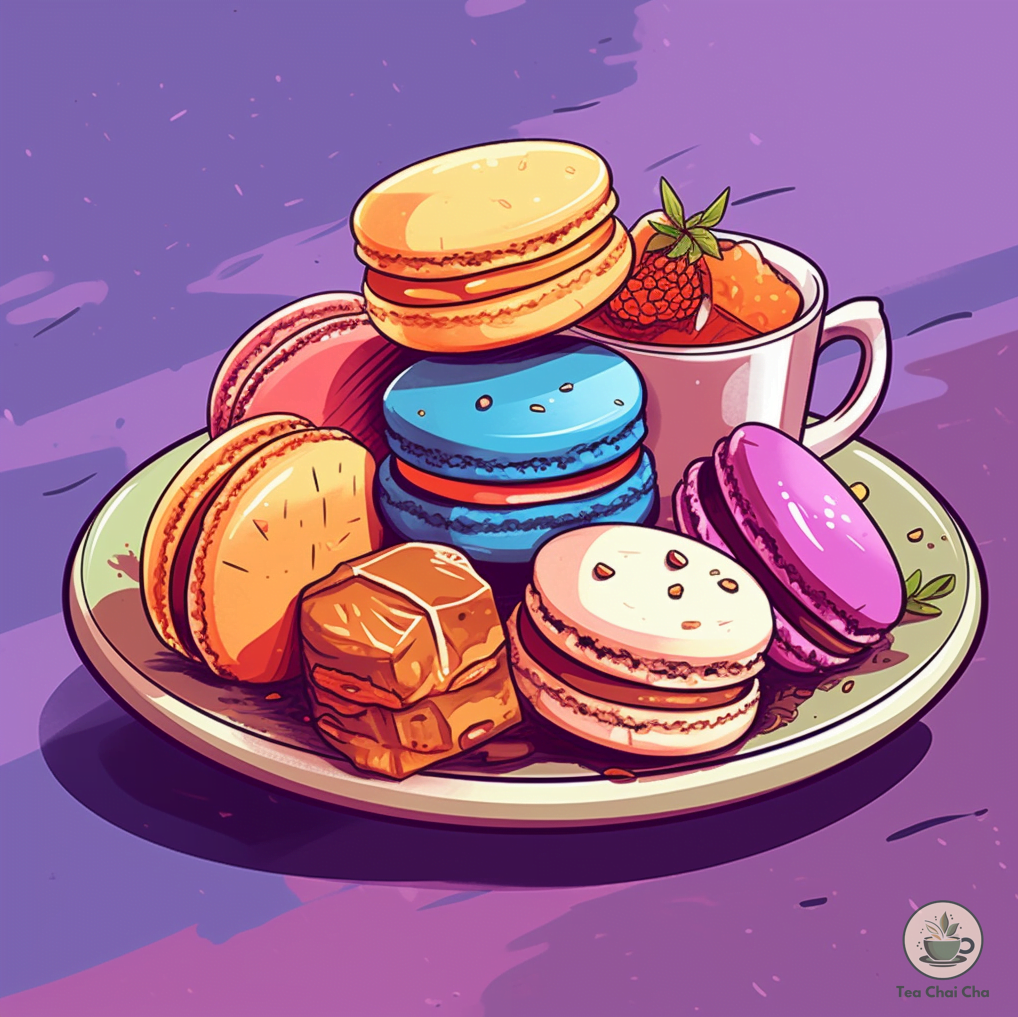
Delicious Black Tea Food Pairings
Black tea has this strong and rich taste that I absolutely enjoy. And you know what’s even better?
Pairing it with some tasty foods!
Here are my top picks for black tea and food combos that I’ve stumbled upon:
Classic English Breakfast Tea with Scrambled Eggs
So, I’ve got this thing for classic English Breakfast tea. It’s got this bold, kinda malty flavor that goes surprisingly well with scrambled eggs.
I mean, you’ve the creamy eggs and then this strong tea that somehow balances it all out. Perfect way to start the day, trust me.
Earl Grey Tea and Lemon Blueberry Muffins
Ah, Earl Grey, you’ve got that flowery taste from the bergamot, and it’s like a match made in heaven with lemon blueberry muffins.
Seriously, the citrusy vibes in the tea just mingle so darn well with those muffins. It’s like they’re having a flavor party in my mouth.
Assam Tea and Chocolate Desserts
Okay, listen to this genius combo I found: Assam tea and chocolate desserts.
I know, sounds random, but that robust Assam flavor actually stands up to the richness of chocolate.
It’s like they’re competing in a tasty game, and I’m the winner enjoying every bite and sip.
Darjeeling Tea with Nutty Treats
Now, Darjeeling tea is this fancy one with muscatel vibes. And get this, it goes surprisingly well with nutty stuff like almond cookies or pistachio cake.
I guess the tea’s delicate flavor and those nutty treats are like old pals catching up. Such a classy duo.
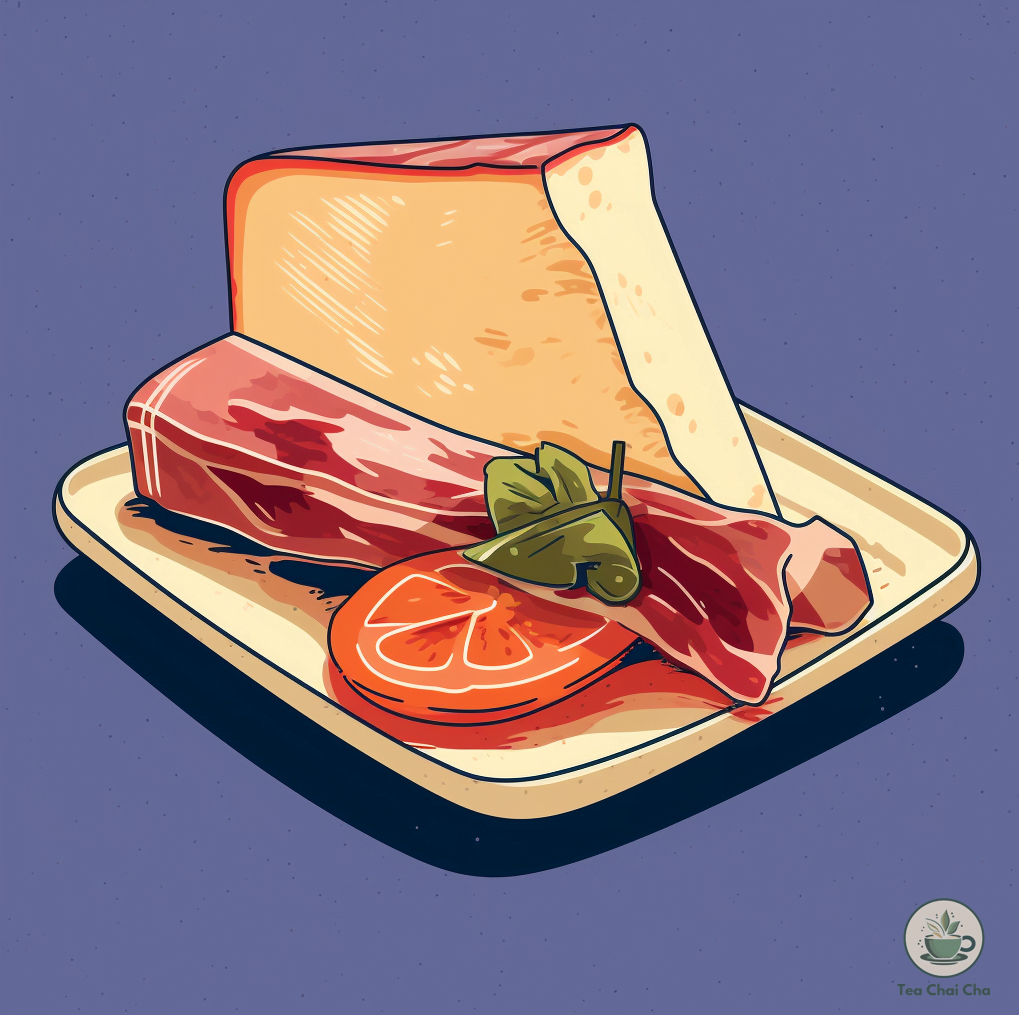
Smoky Lapsang Souchong Tea and Savory Dishes
Alright, time for some adventure with smoky Lapsang Souchong tea.
Imagine pairing it with grilled meats or smoked cheese – the smokiness of the tea just adds this wild layer to the meal.
Chai Tea and Spiced Desserts
Saving the best for last, chai tea! You know, the one with all those spices like cinnamon and cardamom.
Pair that with spiced desserts, like gingerbread cookies. It’s like dessert and a chai latte had a super delicious baby.
So, these are my discoveries, but hey, don’t be shy to try your own black tea and food pairings.
Conclusion
Making black tea is more than just a process; it’s a connection to tradition, a journey of flavors, and a moment of self-care.
Remember, the secret lies not only in the tea leaves but in the care you infuse into each step.
So, whether you’re sharing a cozy chat with a friend or simply taking a quiet moment for yourself, brewing that perfect cup of black tea can truly be rewarding.
Related
Frequently Asked Questions (FAQs)
What are the health benefits of black tea?
Black tea’s rich flavor isn’t its only charm. It’s also a source of antioxidants that can boost heart health and improve digestion. Plus, its caffeine kick can provide an energy boost without going overboard.
Is black tea made with milk?
Enjoying black tea daily can be fine, but moderation is key. Drinking too much might lead to excessive caffeine intake. So, mix it up with other teas to balance things out.
Is it okay to drink black tea every day?
Iced tea is just chilled tea, while sweet tea is iced tea sweetened with sugar. Sweet tea is quite popular in the southern United States, known for its delightful sugary taste.
What’s the difference between iced tea and sweet tea?
Yes, some people enjoy their black tea with milk. It’s called “tea with milk” or “milk tea.” The milk gives the tea a creamy texture and softens the bold flavor of the black tea. It’s a unique twist worth trying!

